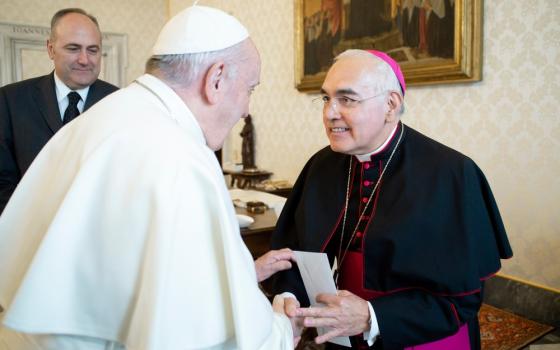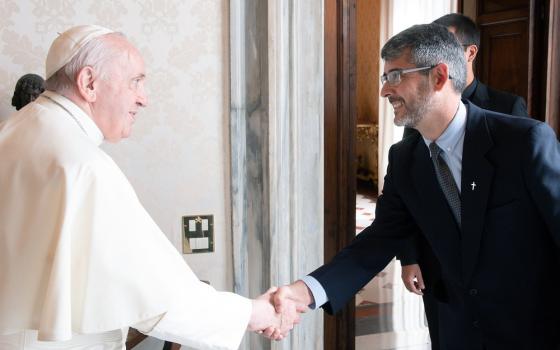Pope Benedict XVI today approved a miracle attributed to Pope John Paul II, clearing the way for the late pontiff’s beatification, the final step before sainthood. The Vatican announced that the beatification ceremony will take place in Rome on Sunday, May 1.
While today’s announcement is expected to be greeted with joy around the Catholic world, critics have raised questions both about the substantive case for declaring the late pope a saint, including his record on the sexual abuse crisis, and the speed with which it’s occurred.
In a statement released this morning, the Vatican insisted that aside from waiving the normal five-year waiting period to begin a sainthood cause, on account of what it described as the “imposing fame for holiness” enjoyed by John Paul II during his life, in every other respect “the common canonical dispositions” for sainthood causes were “integrally observed.”
Organizers expect that the ceremony will attract the largest crowd in Rome since the events surrounding the death of John Paul II and the election of Benedict XVI six years ago, in April 2005.
Formally speaking, beatification entitles a candidate to be referred to as “blessed” but not yet a saint. Traditionally, prayer and devotion to a “blessed” were encouraged only in that person’s local church, but John Paul II’s global appeal means that his beatification will have echoes well beyond his native Poland or the city of Rome.
In the sainthood process, one miracle is required for beatification and another for canonization. (The logic is that the miracles provide proof that the saint is indeed in Heaven and capable of interceding for those who request help in prayer.)
Most of the miracles in sainthood causes are healings, and the Vatican has historically applied three standards to ascertain if a healing qualifies. It must be “complete,” meaning it’s not enough if the person merely feels better or shows some improvement; “instantaneous,” as opposed to a recovery that unfolds over weeks, months, or longer; and it must be “durable,” meaning that the condition does not return. In addition, the healing must be medically and scientifically inexplicable.
The miracle approved today by Benedict XVI concerns a 49-year-old French nun, Sister Marie Simon-Pierre, who was diagnosed with an aggressive form of Parkinson’s disease in 2001 and whose order prayed to John Paul II after his death in 2005 for help. Reportedly, after writing the late pope’s name on a piece of paper one night in June 2005, Sister Marie-Simone awoke the next morning cured and was able to resume her work as a maternity nurse.
Earlier this year, media reports implied that the French sister had fallen ill again and that at least one physician questioned the diagnosis of Parkinson’s disease, suggesting it may have been some other nervous disorder. It would seem that the Vatican resolved those doubts to its satisfaction, however, as the miracle has been approved by both the Vatican’s medical and theological consulters, as well as the cardinals and bishops who make up the Congregation for the Causes of Saints and the pope himself.
Momentum to declare John Paul a saint began almost at the moment of his death.
In the run-up to the conclave that elected Benedict XVI to the papacy in April 2005, some cardinals signed a petition requesting that the next pope move immediately to opening a sainthood process for John Paul II. During his funeral Mass, mourners held signs and chanted “Santo Subito!”, meaning “Sainthood Now!”
Shortly after his election, Benedict waived the waiting period but otherwise held that the usual procedure should be followed.
Among church insiders, it’s taken for granted that John Paul II’s cause will not stall at beatification, but that he will fairly quickly also be canonized and declared a saint.
Given John Paul’s popularity and high public profile, news of his beatification is certain to be a major news event. There are, however, also three persistent strains of criticism likely to resurface in coming days.
First, some Catholic liberals who saw John Paul II as overly conservative have suggested that his cause is being fast-tracked in order to score political points in internal Catholic debates. This constituency has wondered, for example, why John Paul II is being beatified so quickly, when the late Pope John XXIII, who launched a period of reform in Catholicism by calling the Second Vatican Council (1962-65), has not yet been canonized following his own beatification in 2000.
Second, some traditional Catholics may object to the apparent haste in John Paul’s cause, arguing that it risks cheapening the canonization process if there’s a perception that a particular candidate is being moved forward too hastily. Perceptions that the usual process has been “short-circuited,” some warn, may suggest that other church teachings and disciplines can be massaged or set aside. They add that according to Catholic theology, the church has no power to “make” a saint – it can simply ratify that a particular figure is already in Heaven. By that logic, there’s no rush, since if John Paul is indeed a saint, formal beatification and canonization won’t add anything.
Third, some victims of clerical sexual abuse and their advocates believe that John Paul’s record on the crisis is not worthy of sainthood, or at least that beatifying him now risks giving offense to victims who associate the late pope with a mixed response to the crisis. Some have argued that the study of John Paul’s life and legacy as part of the sainthood process did not give sufficient weight to his handling of the sexual abuse crisis, such as the case of the late founder of the Legionaries of Christ, Mexican Fr. Marcial Maciel Degollado, a longtime favorite during John Paul’s papacy who was later disgraced as the Legionaries acknowledged he was guilty of various forms of sexual misconduct.
Yesterday, even before the formal Vatican announcement, the Survivors’ Network of those Abused by Priests issued a statement asserting that the hierarchy is “rubbing more salt into the wounds” of victims with a “hasty drive to confer sainthood on the pontiff under whose reign most of the widely-documented clergy sex crimes and cover ups took place.”
Vatican officials today did not offer any response to substantive criticism of John Paul II, but in past cases when popes have been moved along the sainthood track, they generally insist that beatifying or canonizing a pope is not tantamount to endorsing every policy choice of his pontificate. Instead, they say, it’s a declaration that this pope lived a holy life worthy of emulation, despite whatever failings may have occurred during his lifetime – including his reign as pope.
The date for the beatification ceremony, May 1, has been observed since 2000 as “Divine Mercy Sunday” by the Catholic church. The Divine Mercy feast is associated with a 20th century Polish nun, St. Faustina Kowalska, who was a visionary and mystic to whom John Paul II had a strong personal devotion.
Ironically, May 1 is also “May Day,” traditionally associated with the international Socialist movement, which is striking given that the collapse of European Communism is often flagged as John Paul’s central political accomplishment.




